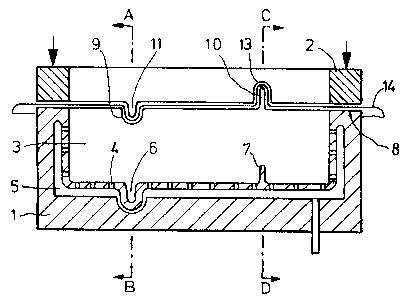Some of the information on this Web page has been provided by external sources. The Government of Canada is not responsible for the accuracy, reliability or currency of the information supplied by external sources. Users wishing to rely upon this information should consult directly with the source of the information. Content provided by external sources is not subject to official languages, privacy and accessibility requirements.
Any discrepancies in the text and image of the Claims and Abstract are due to differing posting times. Text of the Claims and Abstract are posted:
| (12) Patent: | (11) CA 1305301 |
|---|---|
| (21) Application Number: | 1305301 |
| (54) English Title: | VACUUM MOLD FOR MANUFACTURING CUSHIONS WITH BACK-FOAMED COVERS |
| (54) French Title: | MOULE POUR LE MOULAGE SOUS VIDE DE COUSSINS A GARNITURES EN CAOUTCHOUC MOUSSE |
| Status: | Expired and beyond the Period of Reversal |
| (51) International Patent Classification (IPC): |
|
|---|---|
| (72) Inventors : |
|
| (73) Owners : |
|
| (71) Applicants : |
|
| (74) Agent: | SWABEY OGILVY RENAULT |
| (74) Associate agent: | |
| (45) Issued: | 1992-07-21 |
| (22) Filed Date: | 1988-09-19 |
| Availability of licence: | N/A |
| Dedicated to the Public: | N/A |
| (25) Language of filing: | English |
| Patent Cooperation Treaty (PCT): | No |
|---|
| (30) Application Priority Data: | ||||||
|---|---|---|---|---|---|---|
|
Mo-3085
LeA 25,415
VACUUM MOLD FOR MANUFACTURING
CUSHIONS WITH BACK-FOAMED COVERS
ABSTRACT OF THE DISCLOSURE
The invention relates to a vacuum mold for
manufacturing cushions with back-foamed covers, wherein a
section of cover material is stretched across a mold
cavity, held down at the rim of the cavity, but allowed to
slide into the mold cavity under the influence of a vacuum.
The cover is also placed against and fitted to contourings
(ridges and/or grooves) of the mold cavity, and
subsequently back-foamed. The resulting flexible foam core
is allowed to harden and the finished cushion is removed
from the form.
Note: Claims are shown in the official language in which they were submitted.
Note: Descriptions are shown in the official language in which they were submitted.

2024-08-01:As part of the Next Generation Patents (NGP) transition, the Canadian Patents Database (CPD) now contains a more detailed Event History, which replicates the Event Log of our new back-office solution.
Please note that "Inactive:" events refers to events no longer in use in our new back-office solution.
For a clearer understanding of the status of the application/patent presented on this page, the site Disclaimer , as well as the definitions for Patent , Event History , Maintenance Fee and Payment History should be consulted.
| Description | Date |
|---|---|
| Inactive: IPC from MCD | 2006-03-11 |
| Inactive: IPC from MCD | 2006-03-11 |
| Inactive: IPC from MCD | 2006-03-11 |
| Inactive: Adhoc Request Documented | 1995-07-21 |
| Time Limit for Reversal Expired | 1995-01-21 |
| Letter Sent | 1994-07-21 |
| Grant by Issuance | 1992-07-21 |
There is no abandonment history.
Note: Records showing the ownership history in alphabetical order.
| Current Owners on Record |
|---|
| FRITSCHE-MOLLMANN GMBH & CO. KG |
| BAYER AKTIENGESELLSCHAFT |
| Past Owners on Record |
|---|
| GUNTER MOLLMANN |
| VOLKER ONNENBERG |